‘Green’ dams hasten rape of Borneo forests
Tribal peoples are fighting huge hydro-electric projects that are carving up the island's rainforest


In fact it is 52 dams that they are planning to build. See Sarawak Headhunter's previous post "Natives Of Sarawak In These Dam Areas, Beware!" and Btu.org's post "Sarawak to have 52 dams in year 2020" on this.
Since they control the companies that are and will be building these dams and will own the electricity generated from them as well as most of the industries which will use this electricity, essentially Sarawak and Sarawakians will be held to ransom by Taib's family, henchmen and cronies for many more decades to come, long after Taib is dead and gone!
Sarawakians, especially the natives, will just be their coolies forever.
The government of the Malaysian state of Sarawak says the dams are the first stage of a “corridor of renewable energy” that will create 1.5m jobs through industries powered by safe, clean hydro-electricity.
Campaigners are furious but appear powerless in the face of a project they fear will compound the devastation wreaked on Borneo’s peoples and land by previous dam projects and the felling of its forests.
Are the people of Sarawak really that powerless? Let's see!
They point to the ruin caused by the levelling of millions of acres of trees for oil palm plantations to meet the world’s demand for biofuels.
The dams would slice across a vast sweep of Sarawak, a place where wisps of cloud cling to remote, tree-clad peaks, huge butterflies flit through the foliage and orang-utans, sun bears and leopards roam.
There is more than an ecological argument over the scheme. The initial contract has gone to the Chinese state-owned company that built the controversial Three Gorges dam – a project described by Dai Qing, the campaigning Chinese journalist, as “a black hole of corruption”.
From one black hole of corruption to another.
Teams from the China Three Gorges Project Corporation are at work on the first of the 12 new dams at Murum, deep in the interior, from where Sarawak’s great rivers uncoil towards the South China Sea.
Tribal peoples are dazed and frightened, telling a visiting researcher last week that they had been ordered off their ancestral lands. Signs in Chinese were posted all over the project site.
No financial details or contracts have been publicly disclosed. Analysts in China say the work is likely to have been financed in part by a loan from a state institution.
Critics argue that Sarawak does not need more electricity. It produces a 20% surplus and there is as yet no cable to deliver power to peninsular Malaysia – which itself generates more energy than it needs.
Company records filed with the Malaysia stock exchange show that a big beneficiary of the policy is a firm whose shareholders and directors include the wife and family of Abdul Taib Mahmud, Sarawak’s chief minister.
Taib, 72, who drives around in a vanilla Rolls-Royce, is one of the richest and most powerful men in Malaysian politics. He also serves as Sarawak’s finance minister and planning minister.
The family-owned firm, Cahya Mata Sarawak (CMS), has interests in cement, construction, quarrying and road building. It has signed a memorandum of understanding with Rio Tinto, the London-listed mining group, to build a “world class” aluminium smelter that will get its electricity from a dam at Bakun.
More pollution.
The Bakun dam, a separate project due to be completed by 2011, has already displaced an estimated 10,000 indigenous people, leading to bitter legal battles and a chorus of dismay from economists about cost overruns.
Malaysia’s reinvigorated opposition is now campaigning against what it calls “crony capitalism”, helping hitherto powerless tribal peoples to challenge in the courts land grabs and cheating.
For all that, it may be too late to save the natural bounty of Borneo itself. Orphaned orang-utans, piteously holding the outstretched hands of their human saviours, are the most conspicuous symbols of its fragility.
Divided between Malaysia and Indonesia, with Brunei occupying a tiny enclave in the north, Borneo’s riches have ensured its plunder.
One reason is the voracious world demand for timber. The other is the fashion for biofuels made from palm oil. Almost half of Borneo’s rainforests have been cut down. Two million acres have vanished every year as trees are felled, the wood sold and the land turned over to oil palms.
The greatest plunderer of all was Indonesia’s late dictator, Suharto, who doled out timber concessions to generals and cronies during his 32 years in power.
Now the central government in Jakarta is winning praise for a determined crackdown that has slowed the rate of illegal logging.
However, much of Indonesian Borneo is already laid waste. Enormous fires cast a perpetual pall of toxic haze, making Indonesia the world’s third largest greenhouse gas polluter after China and the United States.
“Green gold”, or palm oil, poses an even more insidious threat because it promises prosperity and development to the numerous poor of Borneo – along with immense rewards for the elites.
The vegetable oil comes from crushed palm husks. Long used for cooking, cosmetics and soap, it has now become a principal source of biodiesel fuel.
Malaysia and Indonesia produce about 85% of the world’s supply of palm oil – most of it on Borneo.
The price of this apparently environment-friendly fuel is high. Its damage far outweighs its benefits, according to a recent international study published in the journal Conservation Biology.
One of the research team, Emily Fitzherbert of the Zoological Society of London, concluded that oil palm as a biofuel was “not a green option”.
John Anthony Paul, a Dayak notable in Sarawak, explained it another way: “There’s a stench from the palm oil mill close to my longhouse. There’s a huge quantity of slurry and sludge. Our water is deteriorating. Many fish disappear and there are more floods. Pesticides leach into our soil. The insects start to change, so the pollination changes and so does the quality of our fruits and crops. It’s unsustainable.”
Resistance is growing. Last week two Dayaks walked for four hours, carrying their sharp-edged parangs, or blades, to meet me near a cluster of huts housing Chinese dam workers.
The scene was Bengoh, a place so wild, flower-strewn and lovely that it would have made a tourist poster were it not for the grumble of construction noise and the gouged earth.
The Dayaks are being forced out of their villages because engineers from SinoHydro, a second Chinese contractor, are building yet another dam to improve the water supply to Kuching, capital of Sarawak.
“We are 28 families, in our village since our ancestors,” said Simo Anak Bekam, 48. “The government says we must leave. We want them to recognise our rights to our land.”
The state government says it has offered adequate compensation plus resettlement to new homes with better jobs, health and education.
However, most people in Simo’s village just want to move higher up their familiar mountainside and cannot understand why they must depart for the hot, marshy lowlands.
It turned out to be an example of legal coercion with the familiar echo of “crony capitalism”. Armed with eviction orders, the dam builders told the Dayaks their presence might contaminate the new water supply.
However, lawyers for the villagers found draft plans for the Bengoh dam – drawn up, the documents state, with input from Halcrow, the British consultancy firm – which reveal that unnamed investors plan to build two resorts on the site.
Guess who?
The Dayaks are now fighting for better compensation and the right to stay in the area.
All over Sarawak, tribal people have lost their ancestral lands to similar gambits. “They don’t know that this thing is coming until they hear the sound of the bulldozers,” said See Chee How, a lawyer and civil rights activist.
It is worse deep in the northeast interior, where logging, palm oil and dams threaten the existence of the Penan, a nomadic tribe. Last week a British researcher for Survival International, the campaign group, found people running short of food.
“They hunt but go for weeks at a time without finding a single animal. Fish are also scarce, because the logging silts up the rivers. Sago is becoming more and more difficult to find,” said the researcher, who asked not to be named.
“One old man told me that the changes could be seen in the bodies of the young people, who were thinner and weaker than the people of his generation. The Penan asked me again and again to get news of their plight to the outside world.”
The ravishing of Borneo – its peoples, animals and the land itself – has roots in the past. But there may be a remedy, too.
Sarawak led a romantic, isolated existence under the “white rajahs” of the Brooke dynasty, whose adventurous founder, James Brooke, established himself in 1848 as an absolute ruler. His heirs held power until 1946.
The Brookes disdained the British empire’s commerce and industry, seeking to preserve a noble Dayak culture in all its splendour.
They established native customary rights by which district officers recorded land tenure as a way to stop headhunting wars among the Dayaks. The rajahs also granted leases and published an official gazette.
Malaysian courts have upheld cases based on such documents and now a hunt is on for letters folded away in longhouses and yellowing copies in archives in Britain. For many in faraway Sarawak, it may be their only hope of justice.










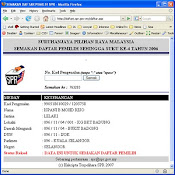















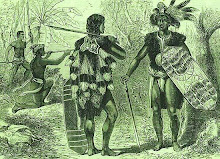





















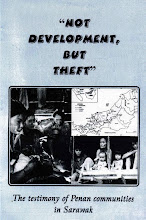
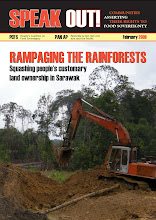





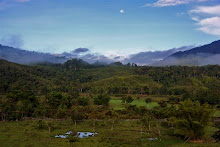



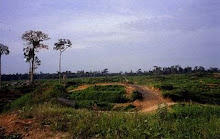























6 comments:
Any royalty to the displaced Dayaks?
http://tunabdulrazak.wordpress.com/2009/03/16/any-royalty-for-dayaks/
It's a sad irony isn't it, that the white rajahs, Englishmen from half way across the world, understood the necessity to preserve native rights, lands and customs. Young Englishmen gave up their lives and youth in defense of that uncompromising Brooke philosophy.
And here you have it today, native politicians destroying Sarawak and its people, just so they can line their own pockets.
How long can a people lay face down in the mud while these criminals run roughshod over them before they say enough? You put these people in power, you can take them down. People throughout history have faced worse but have been able to rise up against tyranny. You just have to want it badly enough.
The Brookes were not as heartless and cruel as our history books portrayed. Our own people are the one who is cruel and heartless.
The most sensible thing to do now in Sarawak is to vote against BN in order to stop this continuing gang rape of Sarawak by taib, his families and cronies. So, if the federal still need the state of Sarawak, by all mean, they must do something about this. It's now or never before it's too late coz nothing can stop the tsunami if it happens.
If the federal keeps their eyes closed on this, trust me, we have no choice but we will go for pakatan rakyat. As long as taib and cronies are history.
I almost cried when I read the story. I'm sorry but the Dayaks deserve this. How can they allow the people who make them suffer to lead them again? There is a Kiswahili proverb that says: "Musiba wa kujitakia hauna pole" (A self iflicted pain doesn't doesn't make people sympathise with one). You are causing yourselves (Dayaks) pain and you want the world and the people of Malaysia to feel for you? The peninsular people don't face this oppression yet they reject Umno and BN, but you who suffer this immense pain continue to choose the same evil leaders. That's machoism. Wake up!
To Anonymous: The true story of the Brookes' rule of Sarawak is to be found everywhere in the official documents they left behind, in the governmental policies they wrote, the laws they enacted, in their correspondence, the books they wrote, and in the books written about them from that period, in the Sarawak Gazette, etc. The truth stands today as in did from 1841 - 1946.
It is a common practice in many newly independent countries to try to rewrite their histories -- changing the history books, the names of buildings, roads, etc., from the past to the newly independent. This revinionist history exists only in that particular country ... everywhere else, people see the truth for what it is.
If you remember, Brooke rule was based on the premise that one day, Sarawak was to be returned to the native peoples. The Brookes were custodians of the country until that time.
There is not a single person who has any true understanding of that part of Sarawak's history that can say that the Brookes became rich from Sarawak. It was quite the contrary. James Brooke used up the remainder of his inheritance on Sarawak and had to beg and borrow from his friends for additional funds he needed to run the country. Charles Brooke was a man who lived like a hermit, and who in the end was obligated to marry a rich woman he did not love, so that he could use her wealth to help the country that he loved. Vyner Brooke is probably the only one of the three Rajahs who reaped the benefit of a prosperous Sarawak when he ceded Sarawak to the British Government for a monetary settlement. I personally think that this was fair.
What is being done to Sarawak now would have appalled them. I can hear them all rolling in their graves ...
People take back your country!
Post a Comment